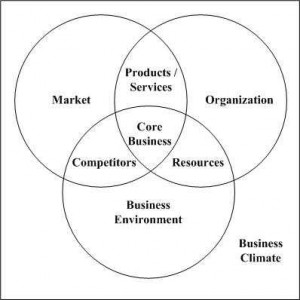In an article in the Harvard Business Review Michael Porter and James Heppelmann ask organizations to reflect on the question ‘What business are you in?’ The suggestion recognizes the way in which information technology is transforming organizations and relationships in trading networks.
The generic business model, focuses on the specific question of ‘What Business are You In?’. The model encourages attention to be given to four main areas: the organization, its market(s), its industry(ies) and the business climate.
- The Organization
The organization is a complex and transformative enterprise that comprises of a formal and informal architecture. The formal architecture includes the defined structures of the organization, such as strategy, systems and processes. The informal architecture reflects the vision, communities, practices and values of the organization. The business model encourages reflection on the current situation in the organization and the value it can provide to the market(s) in which the organization trades.
- The Market
The market is formed by a range of domestic, commercial, service, public sector and not-for-profit customers of the organization’s products and services. Data can be used to categorize customer groups by, for example, demographics or behaviour, to facilitate targeted customer relationship management strategies and contribute to product development. The business model encourages analysis of the information needed by customers and potential customers throughout the process of determining a need for a product or service offered by the organization, through to consumption.
- The Business Environment
The business environment is a network of organizations based in the industry(ies) in which the organization operates, which co-operate, collaborate, compete or supply resources to the organization and its market(s). These organizations offer potential for the organization to add value to its products and services through collaboration partnerships in the supply chain. The business model encourages mutually beneficial trading relationships to be explored.
- The Business Climate
The business climate refers to the wider trading environment in which the organization, its customers and suppliers operate. The business climate recognizes that there are a range of factors that influence the operation of the organization, its market(s) and industry(ies). This includes, for example, legislative, economic, environmental, technological and social factors. The business model can be used to assess the impact of changes in the business climate on the organizational architecture.
Link 1.2 in my book provides a checklist for developing a business model. The business model provides a template within which to filter the complexity of the organizational environment. This enables managers to focus on the fundamental aspects of the organization and reflect on the question, What Business are You In?
Further Reading: the business model is discussed in Chapter ..
Please use the following to reference this blog post in your own work:
Cox, S. A., (2014), ‘What Business Are You in?’, 20 November 2014, http://www.managinginformation.org/what-business-are-you-in/, [Date accessed: dd:mm:yy]

